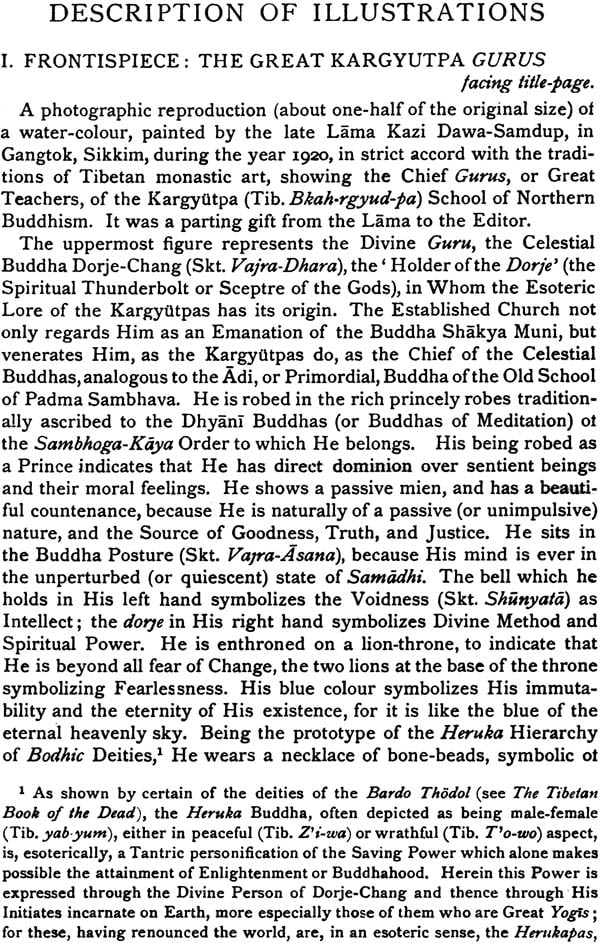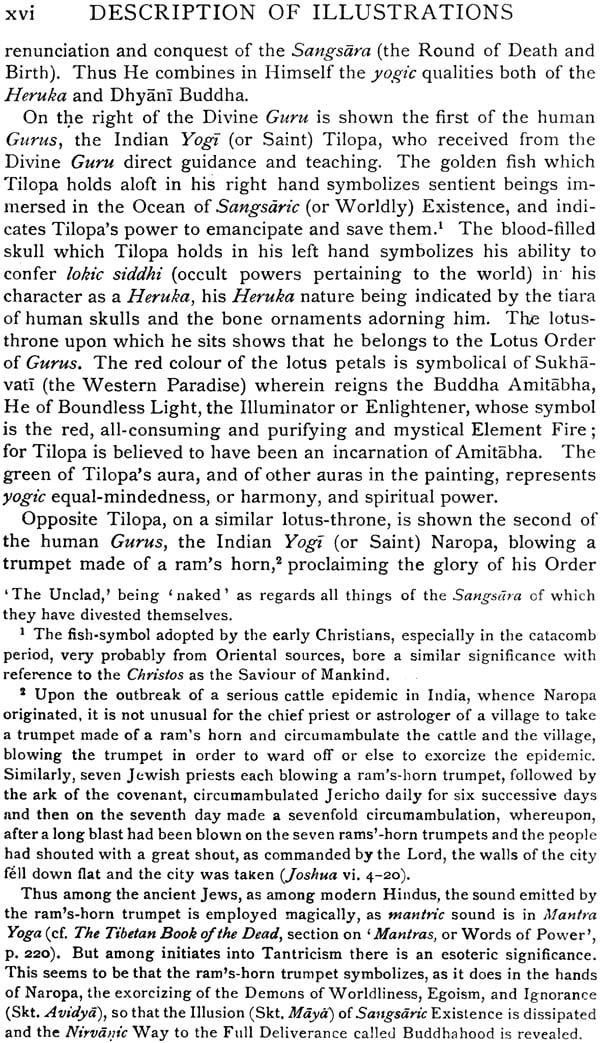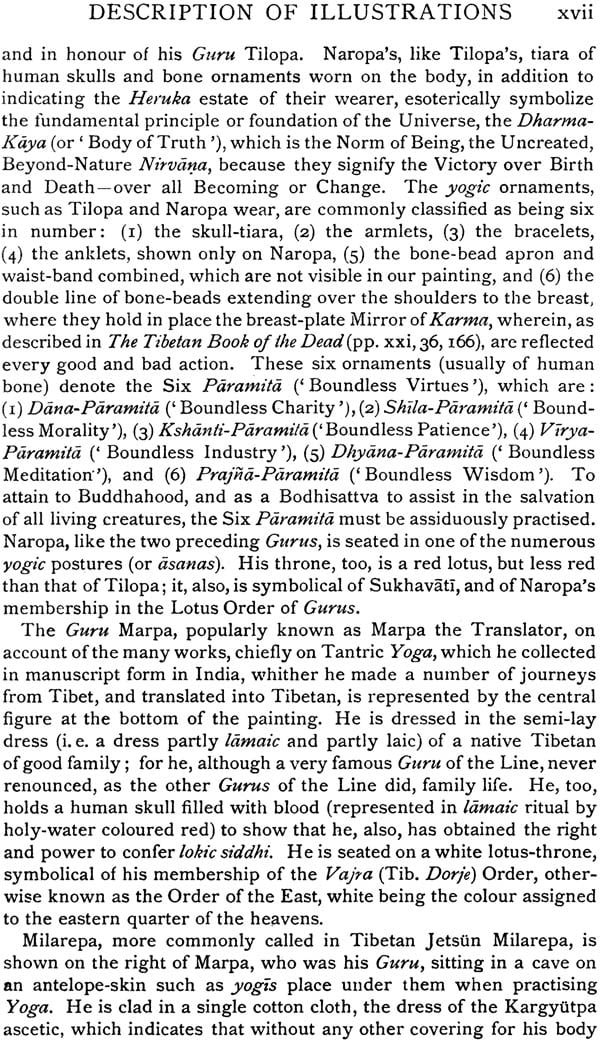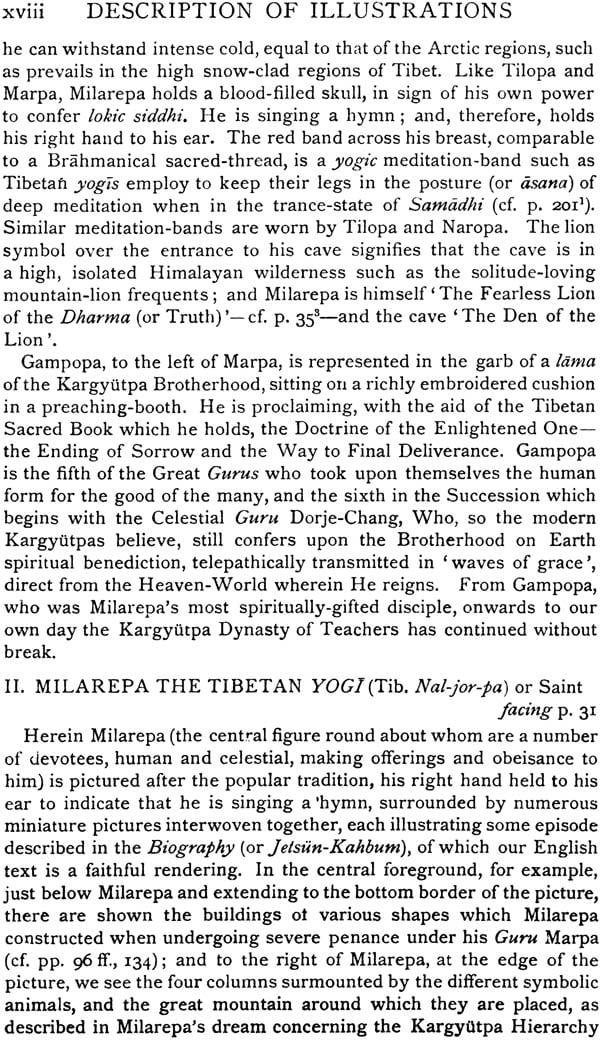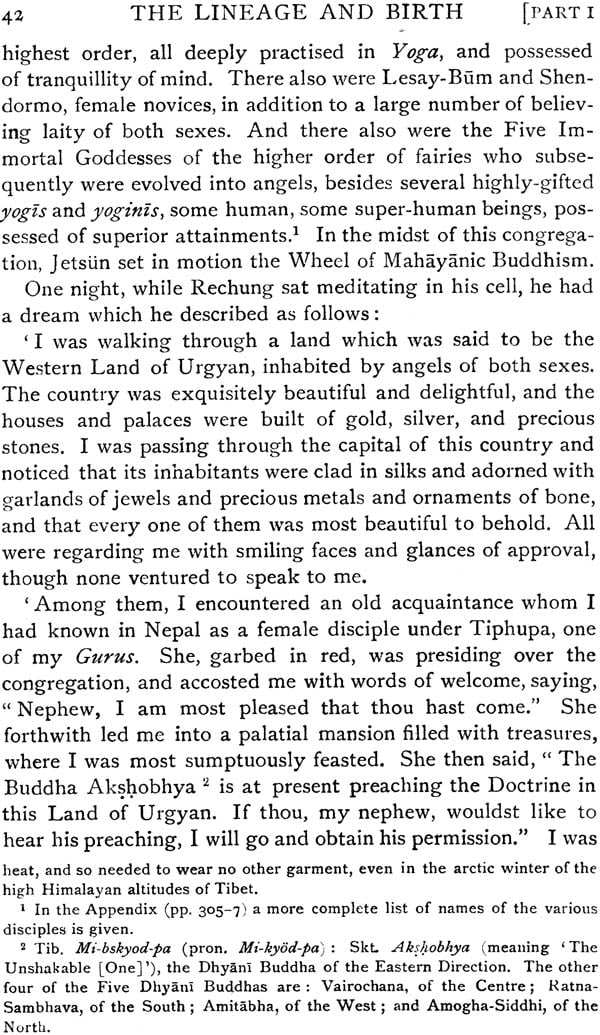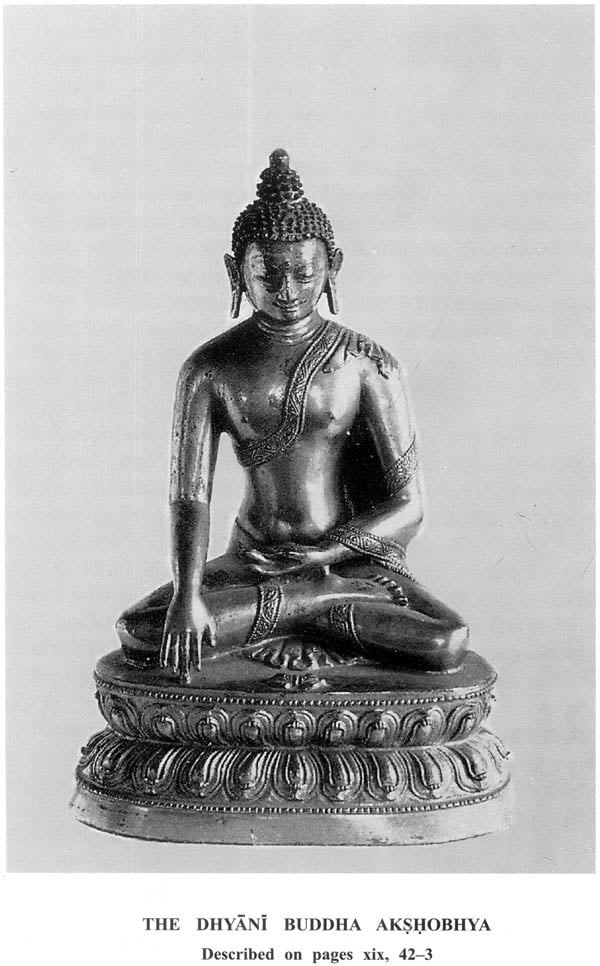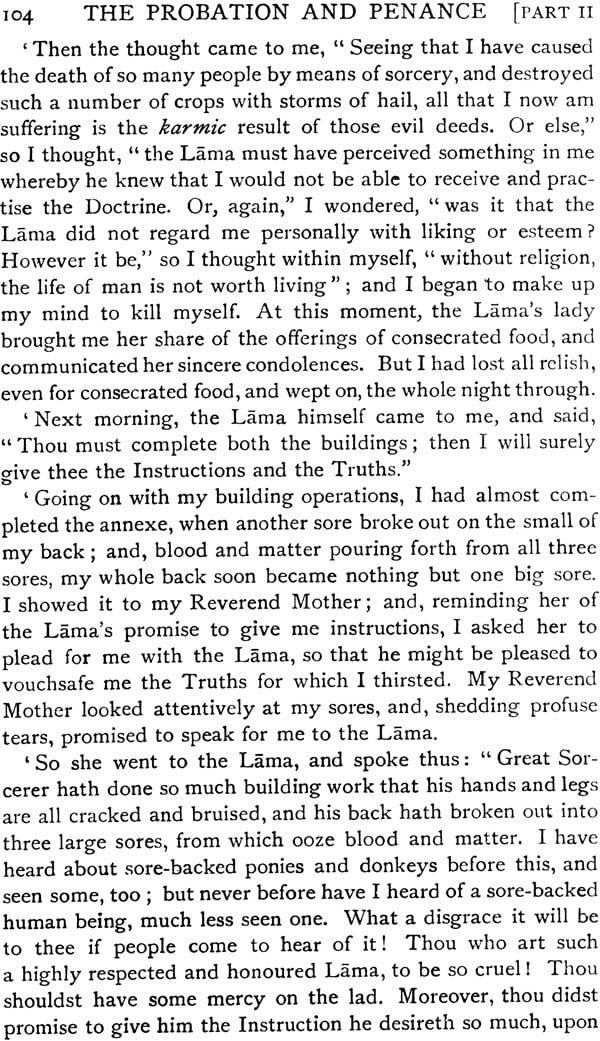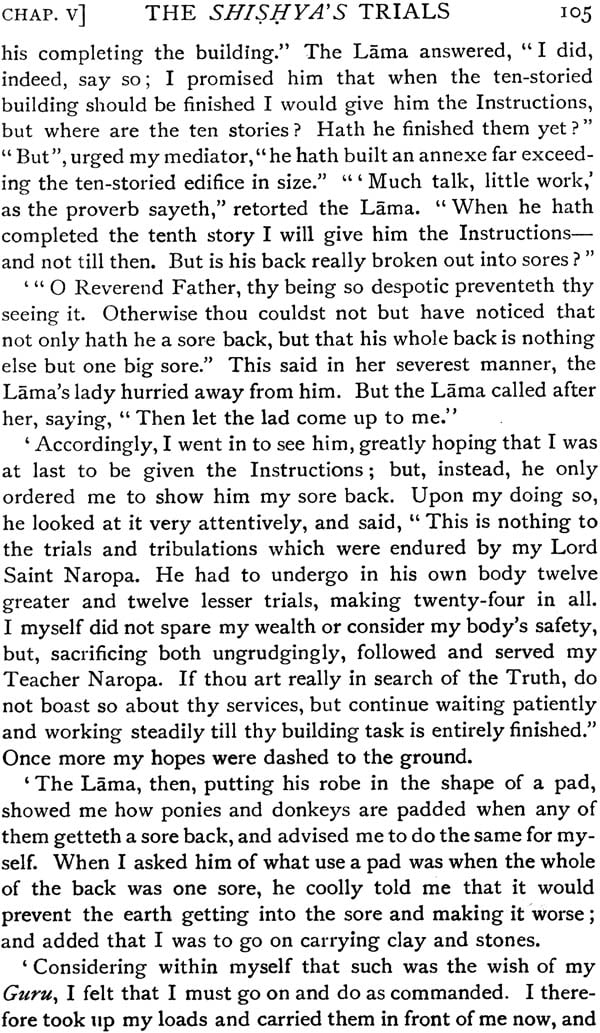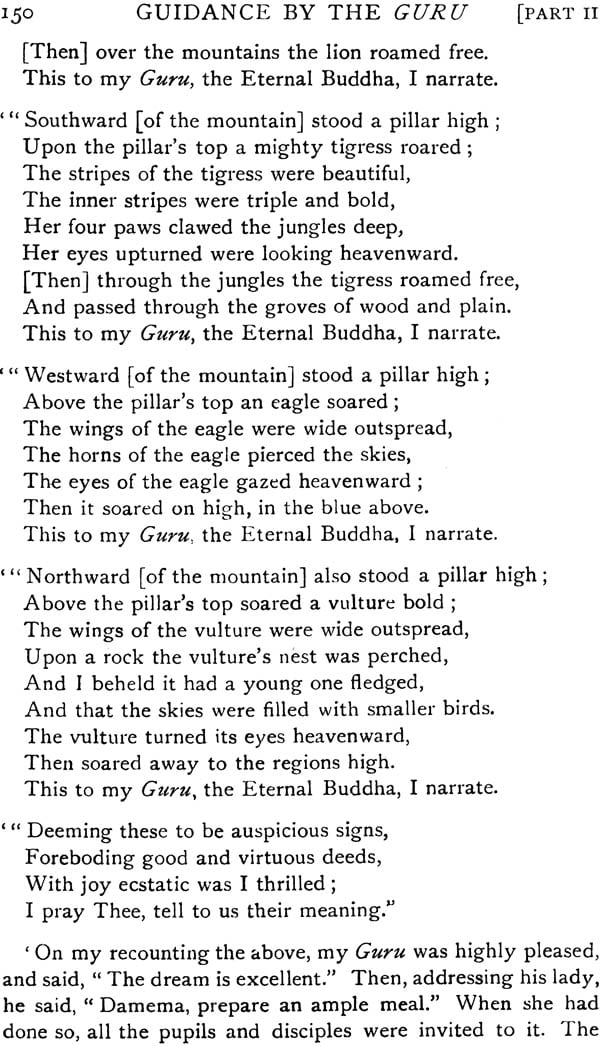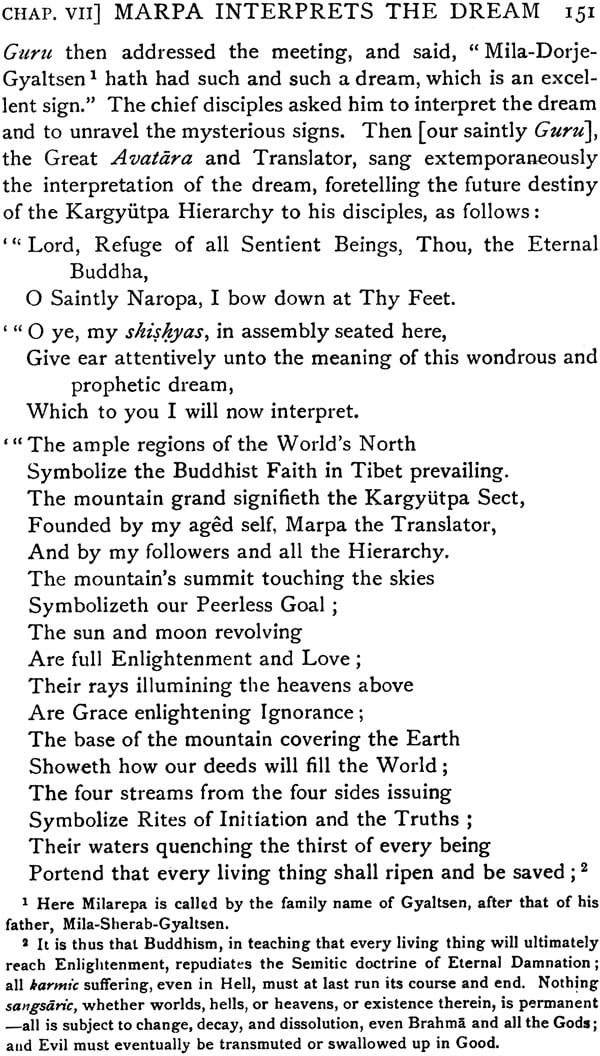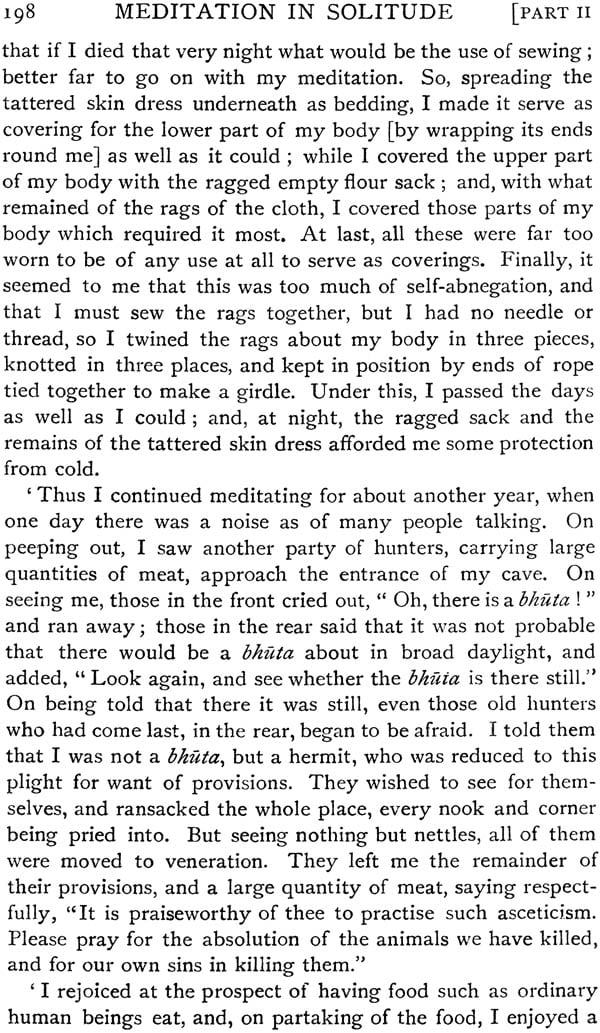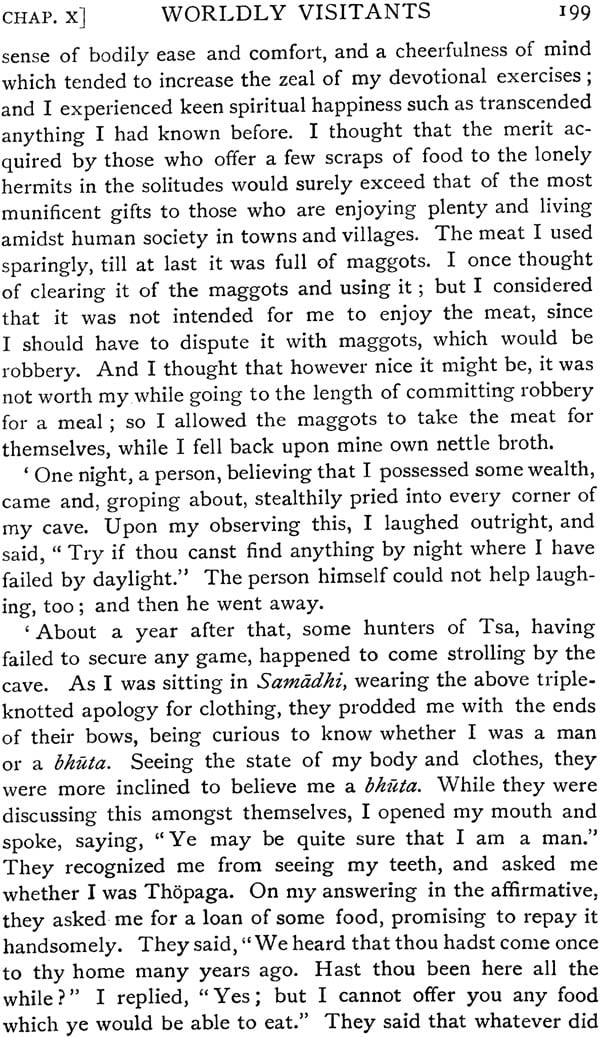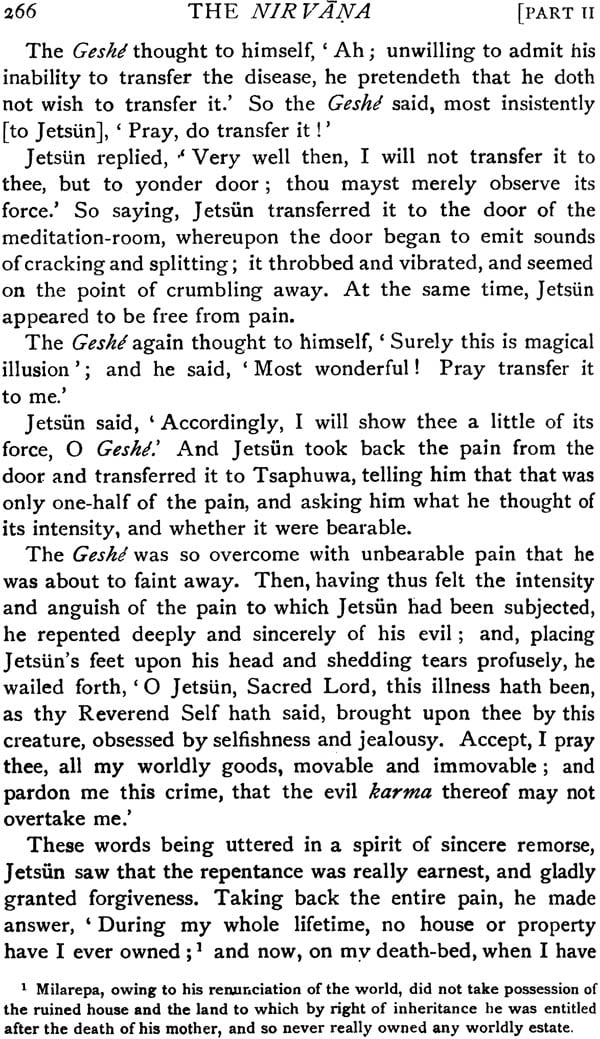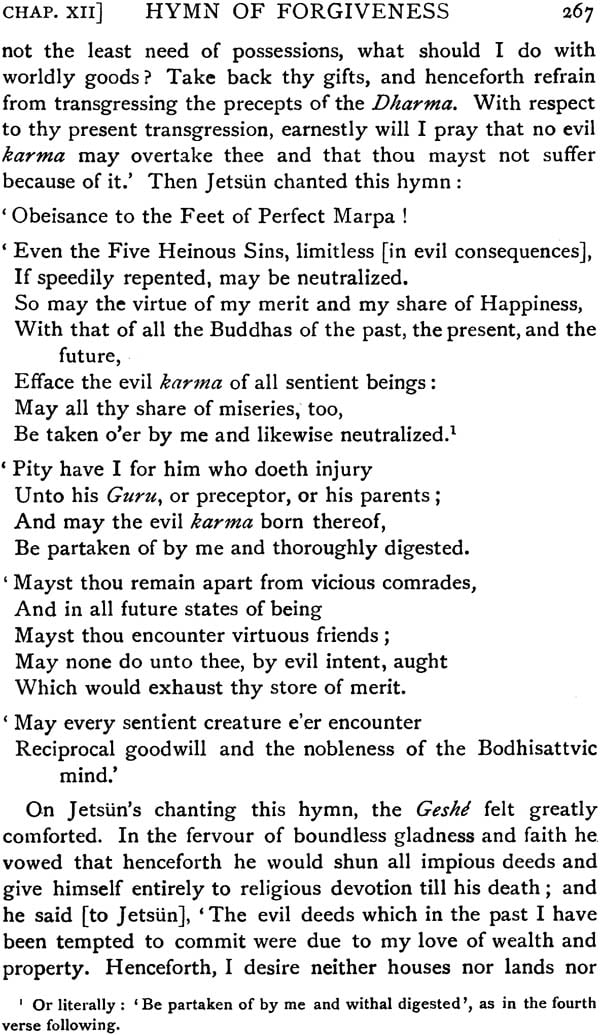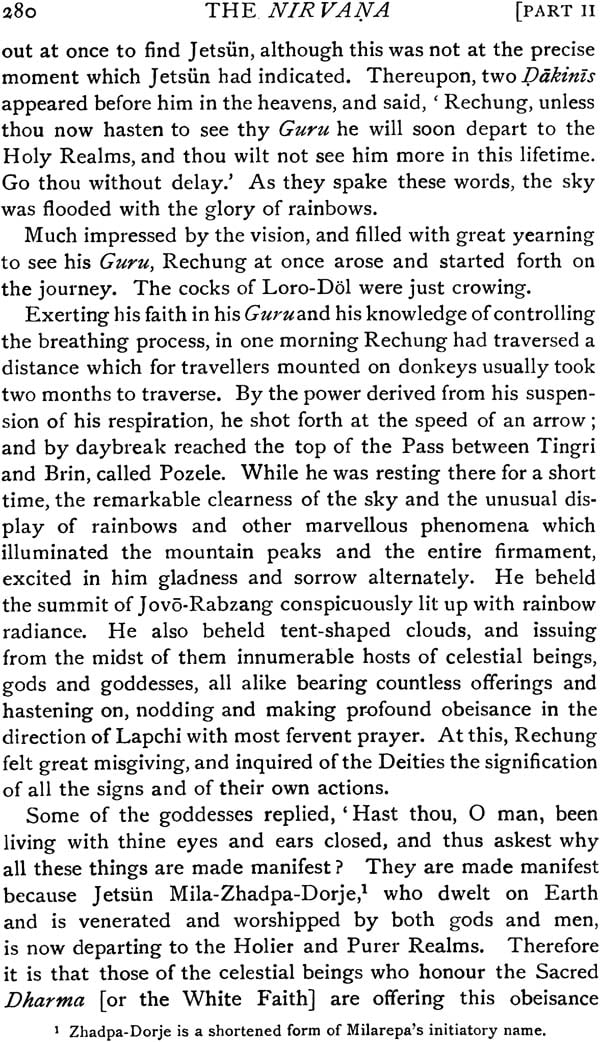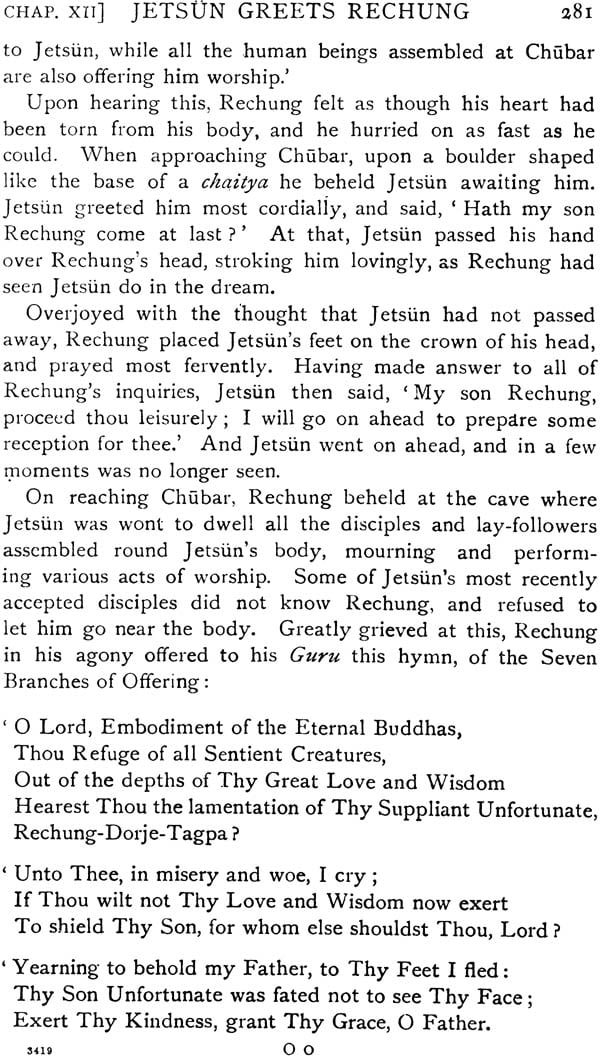
Tibet's Great Yogi Milarepa
Book Specification
| Item Code: | IDI956 |
| Author: | W. Y. Evans-Wentz |
| Publisher: | Pilgrims Publishing, Varanasi |
| Language: | English |
| ISBN: | 9788177690651 |
| Pages: | 315 (Black & White Illus: 5) |
| Cover: | Paperback |
| Other Details | 8.5" X 5.5" |
| Weight | 430 gm |
Book Description
Back of the Book:
Here is an authentic biography of Milarepa, the eleventh-century yogi and poet, who is the most legendary saint in Tibetan Buddhist history. Milarepa is a holy but enchantingly human figure who developed from a vindictive black magician into a supremely powerful yogi, pointing the way to spiritual liberation and complete self-knowledge. This book is replete with authoritative information gathered by the author during his years of wandering through the great Himalaya. The book points out that anthropologically the human race is one family, and that external differences due to hereditary racial characteristics, pigmentation and physical environment are, in fact, purely superficial.
About the Book:
W.Y. Evans-Wentz, an anthropologist, had deep interest in exploring the religious experience of mankind. His other famous books in the present series include Tibetan Yoga and Secret Doctrines, The Tibetan Book of the Dead, and The Tibetan Book of the Great Liberation. Evans-Wentz spent several years in the high Himalaya and on the Tibetan frontiers of Kashmir, Garhwal and Sikkim. He firmly believed that humanity is one family, eternally transcending geographical demarcations, national limitations, and every fettering concept born of the unenlightened mind.
Preface
In my Introduction and Annotations to the present work, as in those to The Tibetan Book of the Dead, I am attempting to convey to the Western World, and so place on record, certain aspects of Higher or Transcendental Mahayanic Teachings, which have been handed on to me for that purpose by the Translator, the late Lama Kazi Dawa-Samdup, my Tibetan Guru. For such defects as critics may discover in my transmission-and I cannot hope to have escaped all error-I alone assume full responsibility.
A part from the greater debt which I as the pupil owe to him who was my preceptor, I acknowledge indebtedness to those Himalayan and Indian Yogis (who prefer that their names be left unmentioned) from whom I had the good fortune, during my wanderings as a research student in India, to gather, at first hand, authoritative information concerning the same ancient ideals of Asceticism and World Renunciation which Milarepa, faithful to his Chief Guru, Gautama the Buddha, has so eloquently expounded in this his Biography. These, happily, still find numerous adherents among Hindus, Buddhists, Jains, Taoists, Islamic Sufis, and even native Christians throughout Asia.
Among my teachers in the Occident, I am also greatly indebted to Dr. R. R. Marett, Reader in Social Anthropology in the University of Oxford, and Fellow of Exeter College particularly for the inspiring encouragement with which he has favoured me in my rather unusual field of anthropological research, even since I first came up to Oxford in the year 1907.
To Major W. L. Campbell, C.I.E., I.A. (retired), late Political Officer representing the British Government in Tibet, Bhutan, and Sikkim, who assisted the Translator in perfecting the translation of the Biography, all readers of this book, as well as the Editor, are much indebted. To Monsieur Jacques Bacot I am under a special obligation for assistance with the transliterations and renderings of Tibetan proper names contained herein, and for the guidance afforded by his interesting and well-illustrated French translation of the Fetsun-Kahbum, entitled Le Poete Tibetain Milarepa (Paris, 1925). I am also his debtor for information contained in two lengthy letters from him, concerning versions and variants of the text.
To Dr. F. W. Thomas, Boden Professor of Sanskrit in the University of Oxford, I am indebted for some suggestions as to spellings and transliterations of Oriental words; and to Mr. E. T. Sturdy, translator of the Narada Sutra, who read the final proofs of the Biography, I acknowledge a like debt.
To my friend in Oxford, Mr. E. S. Bouchier, M.A. (Oxon.), F.R. Hist.S., author of Syria as a Roman Province, A Short History of Antioch, &c., I am exceedingly grateful for aid which he has rendered in reading through and criticizing my version of the translation both when in manuscript and in proof, and for thus facilitating its publication at a time when I found it necessary to leave England and return to my duties in India.
I am, likewise, indebted to Sj. Atal Bihari Ghosh, of Calcutta, Joint Honorary Secretary with Sir John woodroffe of the Agamanusandhana Samiti, for having critically examined the book in the light of Indian thought, especially Brahmanism and Tanticism, as also to Mr. Sri Nissanka, of Colombo, Ceylon, for similar assistance, chiefly with respect to Southern Buddhism; and for the annotations which each has added.
It is the Editor's ardent hope that this book, too, will serve in its own small way to help the peoples of Europe and America to realize that the peoples of the Orient are moved by impulses common to all humanity, and hold fast to religious ideals, in essence, the same as their own; that, anthropologically, the human race is One Family, that external differences due to hereditary racial characteristics, pigmentation, and physical environment are, in fact, purely superficial. Too long has the old barrier-wall, set up in Dark Ages, and built of prejudice and misunderstanding arising from lack of scientific knowledge, been allowed to stand. When, at last, Science shall have demolished it, then will the hour come for the leaders of the races and nations to work not merely for the Federation of the World, but for the Federation of the Truth that exists in all Religions.
I can end this Preface in no more fitting manner than by quoting the Translator's own words:
'That this translation of the life-history of Milarepa might contribute a little to help to make him as well known and esteemed in other lands as he is already in his own was the one wish which impelled me as I worked at my task, and remains my ardent prayer as I lay down my pen.' - W. Y. E.- W.
| PREFACE | vii | |
| DESCRIPTION OF ILLUSTRATIONS | xv | |
| INTRODUCTION | 1 | |
| I. | The Importance of the Jetsun-Kahbum | 1 |
| II. | Historical Value of the Narrative | 2 |
| III. | Tibetan Schools of Buddhist Philosophy | 4 |
| IV. | The Kargyutpa Apostolic Succession | 6 |
| V. | The Modern Successors of Milarepa | 8 |
| VI. | Kargyutpas Compared with Christian Gnostics | 10 |
| VII. | Dissenting Sects | 12 |
| VIII. | Genealogical Tree of Lamaist Sects | 14 |
| IX. | The Defence of the Hermit Ideal | 15 |
| X. | The Arhant Problem | 20 |
| XI. | The Text and its Translation | 24 |
| XII. | The Place of the Jetsun-Kahbum in the Literature of Tibet | 27 |
| XIII. | Milarepa as one of Humanity's Heroes | 28 |
| RECHUNG'S TIBETAN INTRODUCTION | 31 | |
| PART I | ||
| THE PATH OF DARKNESS | ||
| CHAPTER I: | THE LINEAGE AND BIRTH | 41 |
| Telling of Rechung's Dreams, which led to Writing of this Biography; and of Milarepa's Ancestry and Birth | ||
| CHAPTER II: | THE TASTING OF SORROW | 54 |
| Telling of the Death and Last Will of Milarepa's Father; the Misappropriation of the Estate by the Paternal Uncle and Aunt; and the Resulting Sorrows which Milarepa and his Mother and Sister endured | ||
| CHAPTER III: | THE PRACTISING OF THE BLACK ART | 61 |
| Telling of Jetsun's Guru and Mastery of the Black Art; and of how Jetsun destroyed Thirty-Five of his Enemies and the Rich Barley Harvest of the Others, by Magic | ||
| PART II | ||
| THE PATH OF LIGHT | ||
| INTRODUCTION | 83 | |
| CHAPTER IV: | THE SEEKING OF THE HOLY DHARMA | 84 |
| Telling of how Jetsun Obeyed the Commands of his Guru of the Black Art; and of how Jetsun found his Guru of the True Doctrine, Marpa the Translator | ||
| CHAPTER V: | THE PROBATION AND PENANCE | 93 |
| Telling of how Jetsun Obeyed the Commands of his Guru Marpa, thereby Suffering Strange Trials and Great Tribulations; and how, in Despondency, he Thrice Deserted Marpa and Sought another Guru, and then returned to Marpa | ||
| CHAPTER VI: | THE INITIATION | 129 |
| Telling of the Completion of Jetsun's Probation; of Jetsun's Initiation; and of Marpa's Predictions concerning Jetsun | ||
| CHAPTER VII: | THE PERSONAL GUIDANCE BY THE GURU | 136 |
| Telling of the Fruits of Jetsun's Meditation and Study; of Marpa's Last Journey to India; of Jetsun's Prophetic Dream and its Interpretation by Marpa; and of Marpa's special charge to each of his Four Chief Disciples | ||
| CHAPTER VIII: | THE PARTING FROM THE GURU | 158 |
| Telling of how Jetsun, led by a Dream, left his Hermitage, and, going to his Guru, secured permission to visit Tsa, Jetsun's Birthplace; of the Guru's Final Instructions and Admonitions; of the Sorrowful Parting; and of how Jetsun reached Tsa | ||
| CHAPTER IX: | THE RENUNCIATION | 173 |
| Telling of the Disillusionment which Jetsun met when he had reached his Home; and of his Vows to Live the Ascetic Life and Practise Meditation in Solitude | ||
| CHAPTER X: | THE MEDITATION IN SOLITUDE | 182 |
| Telling of how Jetsun entered into Solitary Meditation in the Mountain Solitudes; of the Outer Experiences, and of the Psycho-Physical Results which Ensued; and of his Songs Recording each Event | ||
| CHAPTER XI: | THE HERMITAGES AND SERVICE RENDERED TO SENTIENT BEINGS | 235 |
| Telling of Jetsun's Disciples and Places of Meditation; and of the Recorded Writings concerning Jetsun | ||
| CHAPTER XII: | THE NIRVANA | 244 |
| Telling of how Jetsun came to take Poisoned Curds from Tsaphuwa's Concubine; of the Last Assembly of Jetsun's Followers, and the Attendant Marvels; of Jetsun's Discourse on Illness and Death; of His Final Testamentary Teachings; of the Conversion of Tsaphuwa; of the Last Will; of the Passing Away in Samadhi, and the Resultant Super-normal Phenomena; of Rechung's Late Arrival and Prayer to Jetsun, and the Answer; of the Marvellous Events Connected with the Cremation and the Reliques; of the Execution of Jetsun's Last Will; and concerning his Disciples | ||
| APPENDIX | 305 | |
| COLOPHON | 308 | |
| INDEX | 310 | |
